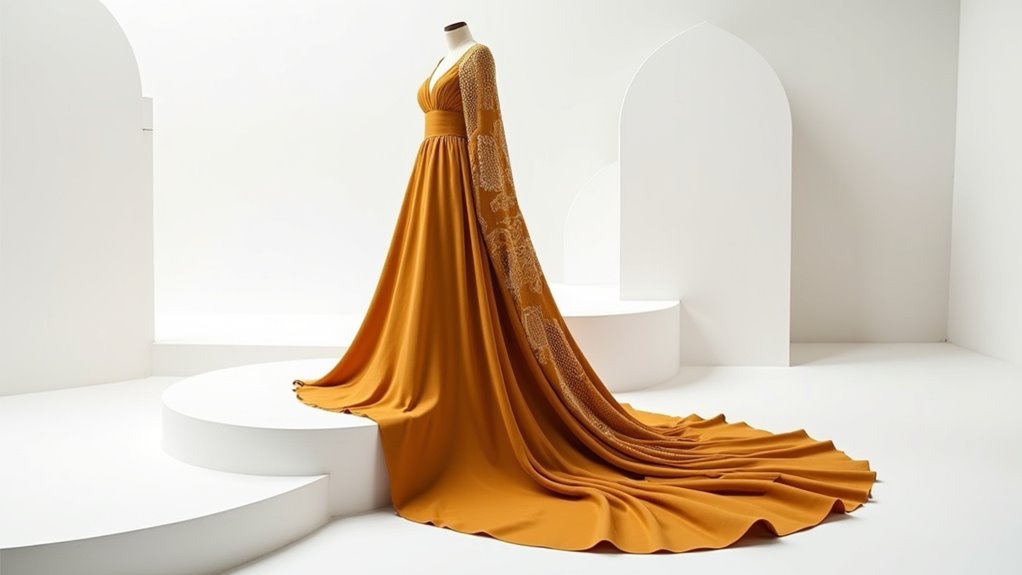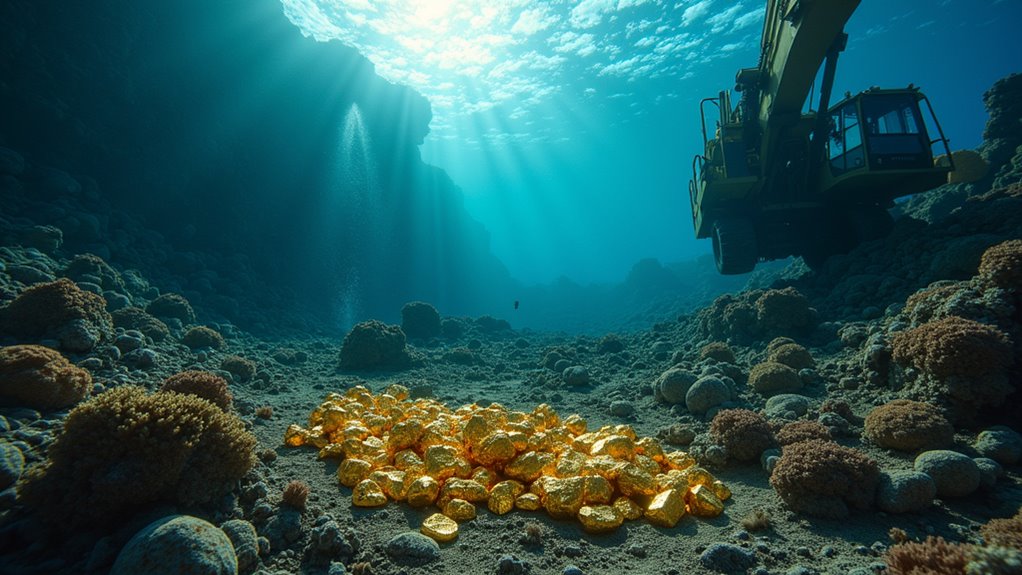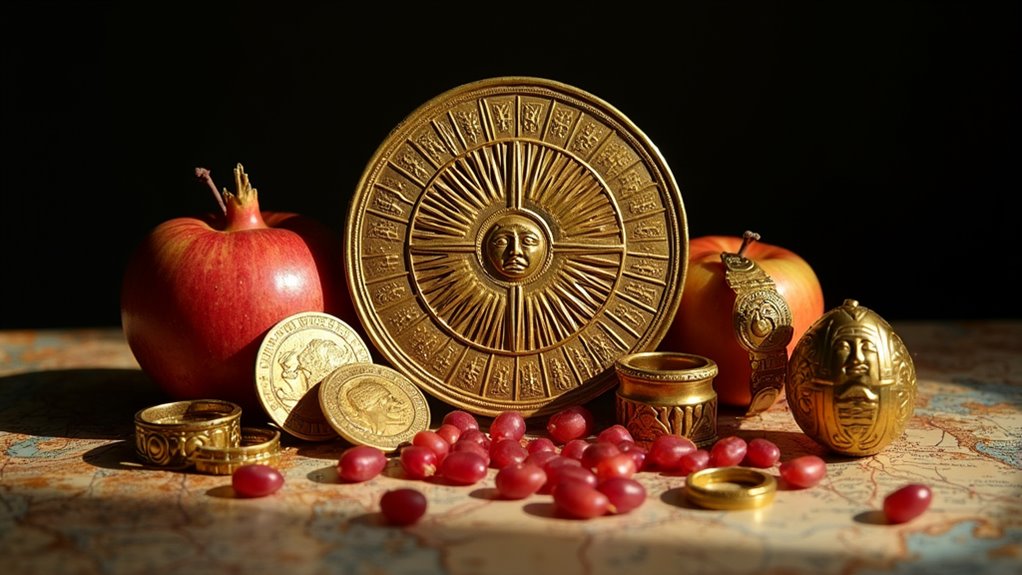Australian fashion designers are incorporating gold elements in revolutionary ways for Spring/Summer 2025. The precious metal appears through innovative textile techniques, asymmetrical designs, and luxury sportswear pieces that reflect Australia’s distinctive style sensibilities. Gold accents complement the season’s dominant yellow palette whilst adding sophistication to tactile innovations like spiralled fringe and feather detailing. This metallic evolution bridges heritage with contemporary approaches, promising fresh perspectives on time-honoured glamour.

While fashion’s evolutionary path often meanders between extremes, the Spring/Summer 2025 collections herald a remarkable fusion of tactile innovation and personal expression. The season’s most enchanting developments showcase an unprecedented blend of textures, with designers like Alaïa introducing spiralled fringe coats and Chanel embracing romantic feathers that create an immersive, sensory experience for fashion enthusiasts.
The Australian fashion landscape has embraced these global trends while infusing them with a distinctly local flavour. The emergence of boho chic styles, particularly those incorporating suede and earthy tones, resonates deeply with the continent’s natural heritage. Yellow hues dominate the 2025 palette, reflecting the sun-drenched landscapes that characterise the Australian terrain, while animal prints pay homage to the nation’s unique wildlife. This interplay of colours and textures mirrors the use of gold leaf in contemporary art, highlighting the significance of luxury in visual aesthetics and its cultural significance across various traditions. The incorporation of luxury gold jewelry into these collections further emphasizes the importance of opulence in Australian fashion.
Australian fashion weaves global trends with local spirit, celebrating earthy tones and wildlife-inspired prints that echo the continent’s natural beauty.
In a remarkable shift towards individualistic expression, asymmetrical designs have gained prominence, challenging traditional tailoring conventions. These non-conformist approaches manifest in uneven hemlines and unexpected structural elements that speak to the Australian spirit of innovation and independence. The trend represents a broader movement towards personalised style that celebrates uniqueness rather than uniformity.
The fusion of sporty silhouettes with luxury elements has created particularly interesting dynamics in outerwear. Technical fabrics paired with sequined dresses exemplify this trend, while fur detailing on nylon materials demonstrates the versatility of contemporary design. This playful approach to styling reflects Australia’s relaxed yet sophisticated fashion sensibilities.
Textile innovations have taken centre stage, with designers exploring unconventional methods to create materials that invite touch. The integration of fringe and feathers in contemporary ways has resulted in sleek, modern interpretations of classical elements. These touchable textures add depth and dimension to collections, creating visual and tactile experiences that resonate with fashion-conscious Australians.
The emergence of romantic elements in fashion has been particularly remarkable, with designers incorporating soft power and elegance into their collections. Simple strapless dress silhouettes and feminine polos demonstrate how classic romance can be reimagined for the modern wardrobe, while evening wear increasingly features delicate, light textures that capture the essence of contemporary sophistication. This evolution in design can be traced back to the rich history of gold jewelry that has adorned and influenced fashion throughout the ages.
This celebration of individuality through fashion extends beyond mere styling choices to encompass a broader philosophy of self-expression. The acceptance of non-traditional details in everyday wear has created an environment where personal style flourishes, and experimental fashion finds its place in the mainstream.
As we move through 2025, these trends continue to evolve, reflecting the dynamic nature of Australian fashion and its unique position in the global fashion landscape.
Frequently Asked Questions
How Does Australian Climate Affect the Longevity of Gold-Plated Fashion Accessories?
Australia’s climate considerably impacts gold-plated accessories’ durability.
The combination of high temperatures and humidity accelerates wear on the plating, while coastal areas’ salt air intensifies corrosion.
Perspiration from hot weather can react with the plating, causing discolouration and deterioration.
Regular exposure to moisture and UV rays weakens the bonding between gold plating and base metals.
These environmental factors typically reduce the longevity of gold-plated jewellery in Australian conditions.
Which Australian Indigenous Designs Have Influenced Modern Gold-Embellished Fashion Pieces?
Indigenous Australian dot paintings and concentric circle patterns have markedly influenced modern gold-embellished fashion.
Traditional motifs like kangaroo tracks and waterholes are frequently incorporated into statement jewellery pieces.
The Staircase to the Moon phenomenon has inspired gold-detailed evening wear, while dreamtime stories are reflected in intricate gold beadwork.
Indigenous symbols of connection to country, such as snake designs and gathering patterns, are prominently featured in contemporary gold-adorned accessories.
What Sustainable Practices Are Used in Australian Gold Fashion Manufacturing?
Australian gold fashion manufacturers employ several key sustainable practices to minimize environmental impact. These include using recycled gold to reduce mining demands, implementing fair trade sourcing protocols, and pursuing carbon-neutral certifications.
Many manufacturers maintain localised production facilities, adopt made-to-order approaches to prevent waste, and utilise blockchain technology for supply chain transparency.
Water-saving methods and renewable energy initiatives are also increasingly common in the industry’s sustainability efforts.
How Do Australian Gold Fashion Prices Compare to International Markets?
Australian gold fashion prices generally trend lower than international markets due to local production advantages.
The proximity to gold mines and refineries reduces transport costs, while domestic manufacturing capabilities help maintain competitive pricing.
However, luxury international brands can sometimes undercut local prices through global supply chains.
Currency fluctuations affect import costs, though online marketplaces increasingly level the playing field for Australian consumers seeking gold fashion pieces.
Where Can I Find Certified Australian Gold Fashion Designers?
Certified Australian gold fashion designers can be discovered through several established channels.
The Australian Fashion Council provides a thorough directory of authenticated designers, while prestigious boutiques across Sydney and Melbourne showcase local talent.
Notable platforms include Sarah & Sebastian, Natasha Schweitzer, and Kirstin Ash’s online stores.
Additionally, pop-up events and fashion expos regularly feature certified designers displaying their craftsmanship, particularly in major metropolitan centres.












